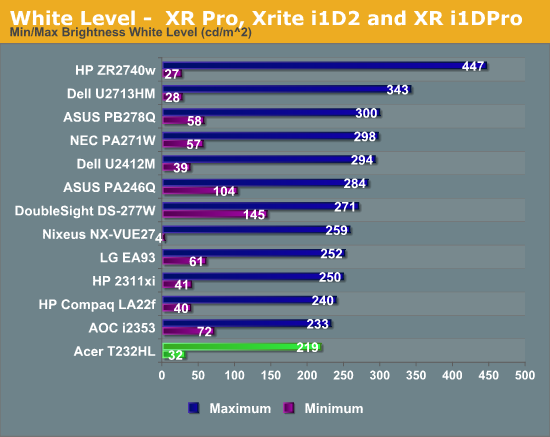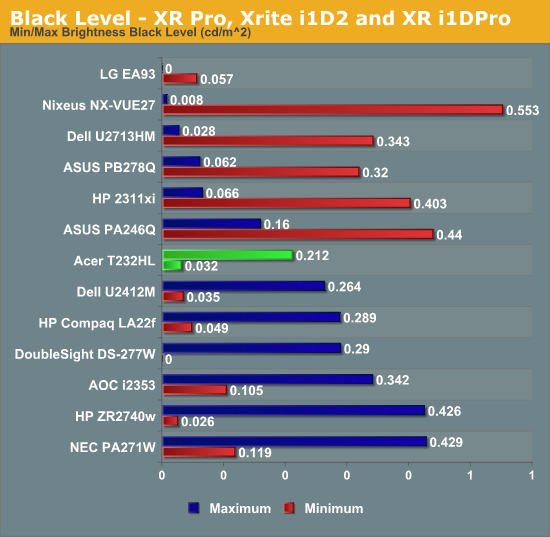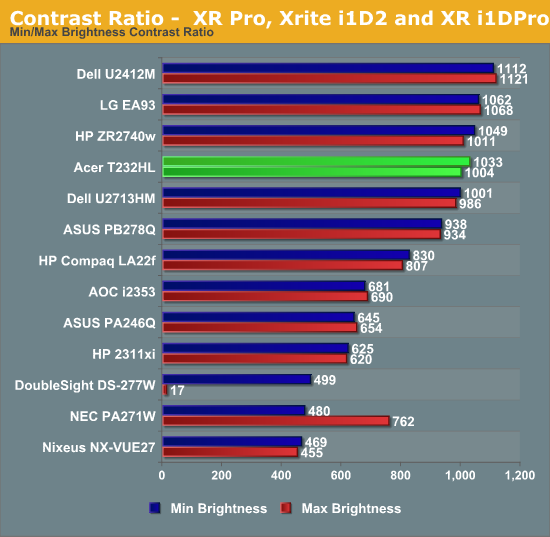Acer T232HL - Touch Comes to the Desktop
by Chris Heinonen on February 6, 2013 9:00 AM ESTBrightness and Contrast
The Acer T232HL uses an IPS panel with LED lighting, so my main curiosity on it was if the touch layer would have a negative impact on brightness and contrast ratios. We’ve seen phones and tablets that maintain very good contrast ratios, but they utilize much smaller screens. With a 23” display I expect to have a good amount of light output, and here the Acer only managed to produce 219 nits with the backlight at maximum. This comes in a bit behind other 23” monitors that I’ve reviewed recently and well behind all the 27” displays that I’ve seen. With the backlight at minimum I managed to get 32 nits out, so you can reduce the light output as much as you would likely want to be able to.

Black level is 0.212 nits with the backlight at maximum and down to 0.032 nits with the backlight at its minimum value. These wind up being really good for a smaller IPS panel, as they typically are a good amount higher. Going back to the touch layer, I’ve no way to test it but if that layer is absorbing 0.1 nits of light, that would lead to almost no change at the white level, but a huge change in the black level.

This small change would make a large change in the contrast levels, and that might account for the contrast levels that I saw in the Acer. Maximum backlight had a contrast of 1033 and minimum had a level of 1004. These are really nice levels and lead to an image with a lot of dynamic punch. The glass front helps to accentuate this a bit as well in comparison to a matte finish, making the Acer really stand out.

I wish the peak brightness on the Acer was better, as 250-300 nits should be the minimum that a monitor can deliver in my opinion. The reflective nature of the glass makes this even more important to me since if you are getting reflections from your lighting, you’ll want to crank the panel backlight up to compensate. If you don’t have glare issues, then the Acer produces contrast numbers that are really nice to see.










66 Comments
View All Comments
pandemonium - Wednesday, February 6, 2013 - link
The only way I can use a touchscreen for a desktop computer will be with a drawing table layout with the screen actually in the desk. *patent!!*Operandi - Thursday, February 7, 2013 - link
Bring on 4K IPS/VA panels and stop making worthless crap.Dribble - Thursday, February 7, 2013 - link
It just doesn't work. You want your arms relaxed in front of you - hence the design for mice + keyboards.Where touch screens work you tend to be looking down at them and have them close to your body so you arms stay relaxed. This is not the case for a desktop monitor - you cannot keep your arms vertically out in front of you for any length of time - it's very tiring.
Hence the whole concept is flawed which anyone with half a brain could have told MS/Acer.
Beaver M. - Thursday, February 7, 2013 - link
Exactly. Though I can imagine, that a hype would press it anyway. Doesnt matter that spine and arm problems will skyrocket after that.TheGreenFoX - Thursday, February 7, 2013 - link
If you have a primary gaming screen with a fullscreen game on, and a touch screen with the metro interface as 2. screen - will the game minimize if you make a touch input on the touchscreen, or can you use the metro apps without minimizing the game?chaoticlusts - Thursday, February 7, 2013 - link
Will be interesting too see how the interface devices due out this year compare with touch screen desktop monitors for convenience.I don't really see touch on a desktop screen being very convenient for most people unless you rearrange your setup around it... and even then it would hard not to be awkward. Touch works great on laptops and smaller devices but I really think if people want the 'hands on' approach with desktops things like Leap Motion or the Kinect 2 will take off rather than products like this. even more so when it means adding a $100 device rather than paying hundreds extra for a touch monitor.
beck2050 - Thursday, February 7, 2013 - link
Touch my screen on a desktop is uncomfortable and unacceptable for me.I would never want a touchscreen there.
ypsylon - Friday, February 8, 2013 - link
It is really one environment where touch screen is nothing more than a nuisance. Imagine situation like this.You have a desk, on a desk is LCD 27"-30". LCD is standing as it should ~50-60 cm from user so his/her eyes won't bleed after 10 seconds. How the hell somebody thinks (Microsoft for that matter) that user will sit even closer, virtually next to a big LCD pushing buttons on the screen. Really laughable idea. Imagine writing something in the office or doing really complicated spreadsheet just with virtual keyboard stretching you arms across the desk. And if user must keep his/her beloved keyboard and mouse because nobody else on the market cares about touch screen software then idea of a touch screen for desktop is as dead as ISA slot on motherboards.
There are environment where touch screen is used for ages: manufacturing, finances (stock exchange), military, engineering and so on. For now home-desktop area is a no-go zone. We haven't exactly reached Star Trek level of computerization where with few taps on a pad you can run a starship. :D
JimmiG - Friday, February 8, 2013 - link
The whole reason Apple went with touch on the first iPhone was to get the most effective use of the limited screen real estate and surface area of a phone.It is *not* the best interface for large screens or desktop computers where a mouse and keyboard is available. This silliness needs to go away.
DagB - Friday, February 8, 2013 - link
Comments like this really bugs me, especially on a site like this... Where is the forward thinking? Do you actually think people will sit with a mouse and keyboard in 20 years to the same extent they do today? There are lots of interesting things happening; touch, motion sensors, haptic technologies and so on. I agree that this is probably not an optimal interface if you mainly type or do normal "office" work. But there are people doing other stuff as well on there desktops. For example all types of "creative" activities (film editing, photo editing, music producing etc).For me as a music producer this is something really interesting, that has the potential to totally change the way we produce, mix, create and edit music. Ipad is way to small/limited for more advanced work, but is still very interesting. If you put a large desktop screen (more) horizontally, you will not get tired after hours of work and would have all the real estate you need. Also, that is the work position producers and sound engineers have worked for decades. I hope this is just the beginning of a change to a more intuitive and "direct" way of interacting with our digital tools. We should embrace it!